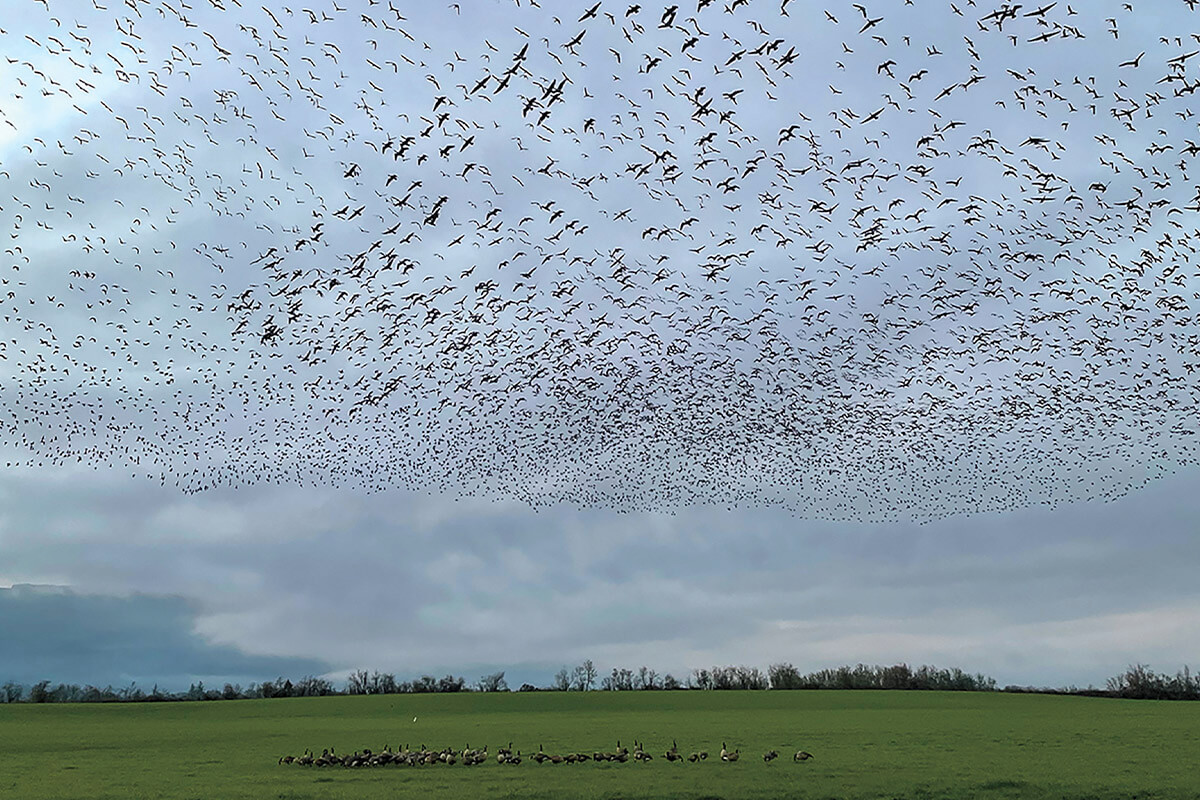
Having a good hide is one of the key factors in bagging more big geese. (Photo By: Scott Haugen)
The geese arose from their roost and headed our direction, just as my buddies and I predicted. But as quickly as our anticipation escalated, it waned. The flock flew by our decoy spread, landing 400 yards beyond us in a wide-open field.
Moments later another flock did the same, followed by a third. With each passing flock we quickly made adjustments to our spread, which consisted of 11 dozen life-size Canada goose decoys. First, we feathered out the ends of the spread, creating slight J’s for geese to land in. Then we removed the J’s and put a small flock on the edge of the big bunch of decoys to simulate a newly arriving and feeding family flock. Nothing helped. We were in for a long morning, as there’s no competing with live birds when it comes to decoying geese.
What Makes Geese Different
The ups and downs of goose hunting can be frustrating. When you think of the range of geese that can be hunted throughout the country, from early in the fall, through winter, and into spring, the task can seem overwhelming.
I’ve found the key to successful goose hunting starts from the neck, up. In other words, use your head and hunt smart. Pay attention to details and don’t get consumed by the big picture.
Duck hunting is different. Hard work and a dozen decoys can find you experiencing a memorable duck hunt. But with geese, hard work can lead nowhere, which is why thinking your way through and analyzing each hunt is important.
No matter which season you’re hunting, scouting could be the most important element of goose hunting. This is even true for the September season, when geese are in family units, have a routine, and are gullible to a dozen or less decoys. Then again, geese are smart and quickly grow wise to pressure, even in early fall.
Goose Hunting Do’s & Don’ts
Decoys: Not only will geese become wise to hunters as the season progresses, they’ll also grow smart to decoys, blinds, and sub-par calling. In the areas I hunt honkers and cackling Canada geese, you can put away the silhouette decoys once November hits. While silhouettes work in September and the first hunt or two in early winter, they simply aren’t as effective as life-sized decoys. I’ve witnessed flock after flock avoiding them, flaring from afar. Whether this is because so many hunters are using silhouettes in my region, or other factors related to the hunt, I’m not sure, I just know what does and doesn’t work for me.
Blinds: Having a goose blind with a small footprint is important. I’d rather have a low-profile A-frame with four hunters than four layout blinds we have to scramble to effectively brush-in. Be sure all vertical and horizontal edges of blinds are brushed-in, and make certain there are no black holes birds can see when passing overhead; this includes open doors of layout blinds. Keep movement to a minimum as geese approach, and avoid the urge to poke your head out of the blind to locate birds.

Goose Calling: Once geese start committing, I stop calling, and never call while a flock is passing overhead. A lot of times it’s the call that turns geese my way-especially on foggy days-and once they dial-in to the source of the sound, I go silent, letting the decoys do the work. If approaching geese hesitate or lean toward live birds, I’ll continue calling, often more aggressively in an effort to regain their attention. I’ll also wave a flag to keep the focus of these geese. Don’t call just to call. Call with reason, taking into account bird behavior, wind direction and intensity, and current weather conditions.
Goose Hunting 2.0
If the first flock of approaching geese flare, change something. Don’t wait. Step out of the blind and assess what went wrong. Was it fabric draped over your blind, blowing in the wind, that caused them to turn? Or was it a blob of decoys that looked out of place? Maybe the blind wasn’t properly covered, or the right color.
My main goose hunting buddies, the Kropf brothers, and I hunt geese a lot. We average three days of scouting for every hunt. Not only do we want to know exactly where geese are feeding prior to putting up blinds and setting decoys, we want to know how long they’re spending in a specific place, if they’re moving throughout the day, if they return to water late in the morning and go back to the same place to feed or go elsewhere in the afternoon. We plot their watering areas and nighttime roosting sites, and track flight paths they use to reach feed based on wind direction, storms, even hunting pressure.
Once geese leave a feeding site we often walk the area to see where blinds can be erected. Sometimes a ditch line or trees offer cover; sometimes it’s a wide-open field with shoelace high grass, meaning no blind can be set. When this happens, we’ll sometimes use a tight pack of decoys to hide in, but often we simply can’t hunt the spot due to lack of cover.












































